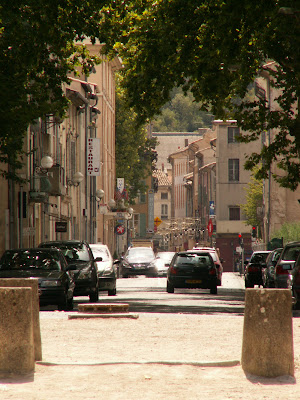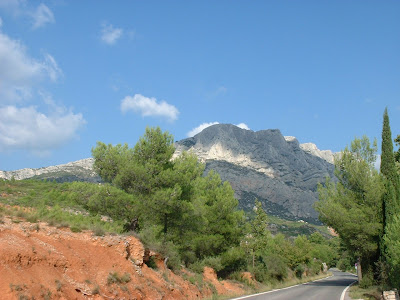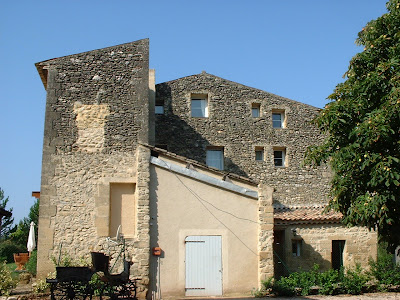Provence is an old-fashioned love affair that’s vivid in
every tourist’s mind. It embodies
everything that is quintessentially “French”. The idyllic sun-drenched
landscapes filled with scented lavenders, olive groves and chestnut trees; the
locals leisurely sipping express at quaint outdoor cafes; the festive markets
in town square selling all sorts of local delicacies and gastronomic art de
vivre. It's a place that takes you to
different place and time.
So, it’s no wonder that we fell in love with Provence on our first road trip to Southern France, and we kept going back for many more
years.
Aix-en-Provence
Aix-en Provence is perhaps one of the most idyllic towns
in Provence, and everywhere you turn, it feels as if you’ve just stepped into
an impressionistic painting. Cours
Mirabeau is a street made for strolling, and Atelier de
Cézanne (the last workshop of Cézanne) is definitely a must see. Also, I highly recommend the drive out to Mont
Sainte Victoire, as the landscape, which is
exactly as Cézanne had painted it, is absolutely stunning.
The only downside is that due to its popularity,
Aix-en-Provence can be packed with tourists throughout the year, which also
true for Provence in general. Try to
avoid visiting this area especially during the summer holidays, as you’re likely to
encounter more British tourists than locals.
Therefore, we prefer to stay outside of the city center at one of the many lovely country houses or farms that have been converted to B&B’s (called Mas). Our favorite is la Chêneraie (Bastide du Plan, 13840 Rognes tel.: +33 442 501 901); however, we also loved these hotels in and around Aix.
In Aix-en-Provence:
Outside of Aix:
Arles
If someone were to ask me for my favorite town in Provence, I
would have to go with Arles. Although
the town has changed quite a bit since the first time we were there, Arles
still has, and always will have a special place in my heart.
Sometimes called the soul of Provence, this town on the
Rhone attracts art lovers, archaeologists, historians, and even pilgrims on the
route to Santiago de Compostela.
Everywhere you turn, you feel as if you’ve just stepped into one of van
Gogh’s painting, and the town is filled with Roman artifacts that are in better
shape than in Rome. It could be because
Arles was a Roman colony during the reign of Julius Caesar, and Constantine the
Great named it the second capital of his empire in A.D. 306, when it was known
as "the little Rome of the Gauls."
 |  |
 |  |
 |  |
 |  |
 |  |
 |  |
 |  |
 |  |
 |  |
All the years we've visited Arles, my husband and I have been privy to so many fun and quirky events and celebrations. However, our favorite is the Feria du Riz (Rice Festival),
which takes place in September. It's a three-day blowout celebration that takes place throughout the entire town, and the Spanish toreadors are invited to perform the Spanish style bullfighting (refer to Hemingway's Death in the Afternoon) at the main Amphitheater. It's a truly spectacular event unique to this region.
 |  |
the Festival of Rice
Here are some of our other favorites in Arles.
- Hotel Calendal – a beautiful hotel ideally situated directly in front of the Amphitheatre
- l’Andaluz – an absolutely charming restaurant that serves up the best seafood soup I’ve had in France
- outdoor market on Saturday on boulevard des Lices, is – the largest in Provence
Avoid: Arles, or Provence in general, in August when
the entire region turns into a tourist hell.
Hotel de la Muette, there are only few places in the world where I
choose to remember the negative experience I’ve had so that I could remind
myself never to go back, and this hotel is definitely one of them.
Avignon
Avignon is stunningly beautiful yet relaxed at the same. It embodies a wonderful mixture of chic, elegance and perfectly preserved medieval splendour. Be sure to check out: the world's largest Gothic palace, the 14th-century Palais des Papes and Place de l’Horloge.
Eyguieres
After being surrounded by English speaking tourists, I
long to be around the locals and to speak French. That’s when my husband and I head over to Eyguieres, a
quiet little village about 30 minutes east of Arles. The drive is gorgeous, and we love sitting in one of the cafes and just soaking up the provincial atmosphere.
 |  |
Gorde is a picturesque little village that seems too beautiful to be real, and judging from the busloads of
tourists, I assume that the rest of the world knows it too. Nevertheless, for the first time visitor to
the region, Gorde is a must see, as the majestic sight of Gordes's ancient
stone houses rising in tiers above the Imergue Valley is an image that you
should not miss.
 |  |
Les Baux de Provence
Les Baux truly is an anomaly. Aside from being one of the most picturesque
villages in Provence, in its lonely position high on a windswept plateau
overlooking the southern Alpilles, Les Baux seems to be part of the mysterious,
shadowy rock formations themselves.
Nevertheless, don’t let its regal façade fool you, as the warmth and
hospitality of the locals will draw you in.
 |  |
 |  |
Marseille
By the time we'd arrived in Marseille at the end of our road trip, we'd seen so many beautiful places that we didn't appreciate all that the city had to offer. Throughout the trip, we visited mostly smaller cities and towns, and being in the second largest city in France seemed overwhelming and crowded. Nevertheless, we enjoyed the food and like the lively atmosphere in the evening.Orange
To me, Orange will always be the best kept secret in Provence. It is without a doubt one of the most charming little towns in the region, and my husband and I have such fond memories of visiting Orange on our first road trip and staying in Hotel St. Florent, which has become one of our favorites in France.
 |  |
 |  |
Pont du Gard
We'd found Pont du Gard on our way to Nimes. Then, it was just another undiscovered ancient Roman archeological site like many others in that area, all of which have been well-discovered in the last decade. It's no wonder that Pont du Gard has become one of France's most popular tourist attractions, as it is one of the best preserved ancient Roman aqueduct bridges in Western Europe. However, my husband and I will always remember it as a serenely beautiful place where we took long walks along the stream and hiked by the moonlight.
Roussillion
There is no mistaking Roussillon. This little picturesque village perched on top of the hill is orange-red … literally, the entire village. The distinctive color is due to the ochre mine below the village. It creates a fascinating 'out of this world' experience like a miniature version of Bryce Canyon National Park, in the US.
The color of the rocks in the mines mirrors the colors of the houses in Roussillon village itself, which makes it uniquely different than other villages in the region. If at all possible you should try to visit Roussillon at dusk to see the glowing colors of the house at their most stunning.
 |  |
St Remy de Provence
Even though tourists have long since discovered St-Rémy-de-Provence, it hasn't eroded the charms of this delightful market town at the foot of the Alpilles mountain range. The medieval streets of the Vieille Ville (Old Town) jumble together to form a maze filled with upscale boutiques and pretty shops stocking Provençal products, and plane trees shade the cafes and restaurants along the wide boulevard that circles the old town, which gives it the quintessentially provincial feel and atmosphere.
 |  |
 |  |
The Gorges of the Ardèche
The river that carved these
canyons is the most temperamental of any French waterway. Its ebbs and flows
have created the Grand Canyon of France. Riddled with alluvial deposits,
grottoes, caves, and canyons more than 950 feet deep, the valley is one of the
country's most unusual geological spectacles. A panoramic road (D290) runs
along one rim of these canyons, providing views over a striking, arid
landscape.
 |  |









































0 comments:
Post a Comment